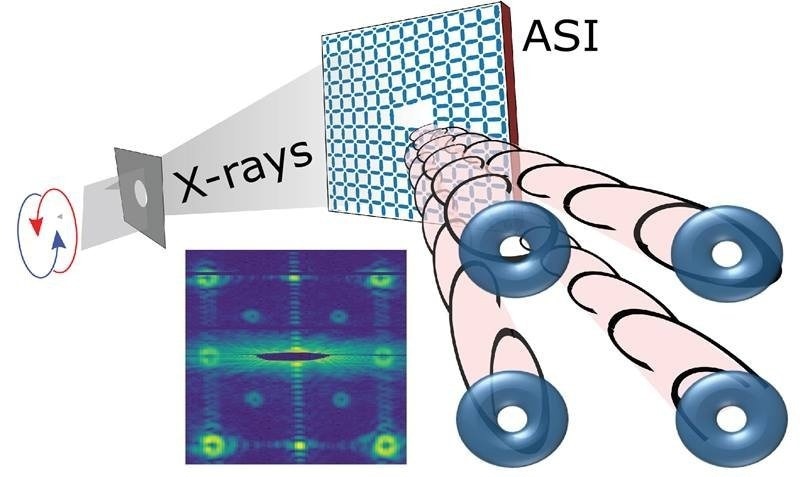Orbital angular momentum (OAM) is the angular momentum of a chosen center of rotation. It is an essential property of the electronic structure present in materials, resulting in magnetism. “Twisted” X-Ray beams carrying OAM hold excellent promise for imaging and probing materials at the nanoscale.

X-Ray photons scattered from a patterned array of nanoscale magnets acquire a twist that is related to orbital angular momentum. The X-Ray beams can be switched on and off with temperature and magnetic fields. Inset: experimental X-ray diffraction pattern. Image Cap: University of Kentucky. Adapted from J. S. Woods et al., “Switchable X-Ray Orbital Angular Momentum from an Artificial Spin Ice.” Physical Review Letters 126, 117201 (2021).
Now, a new method has been fabricated and illustrated by researchers that makes use of a unique patterned array of engineered nanoscale magnets to impart OAM to X-Ray beams. It is possible for the X-Ray beams to be switched on and off with the help of changes made in magnetic fields and temperature.
The Impact
The newly developed nanofabrication methods have verified researchers’ predictions regarding the interaction of patterned arrays of nanomagnets. In this study performed, researchers analyzed an artificial spin crystal or spin “ice” and how it interacts with X-Rays.
Such artificial spin ices are comprised of arrays of nanomagnets. Scientists could tune such magnets’ properties for various applications. The research sets the stage to use artificial materials as reconfigurable X-Ray optics to produce and switch X-Ray OAM beams. The consequent twisted beams are beneficial for learning about magnetic materials.
Summary
The orbital angular momentum (OAM) of visible photons can be used in areas as diverse as optical tweezers, quantum cryptography, and telecommunications. At present, there is a quickly increasing interest in X-Ray OAM for probing and imaging materials at the nanoscale level.
The research group of the new study had scientists from the University of Kentucky, Argonne National Laboratory, Lawrence Berkeley National Laboratory, Brookhaven National Laboratory, and the University of California, Berkeley.
Here, the ASI considered is based on a square lattice with an organized defect at its center. The scientists verified that this structure orders antiferromagnetically at room temperature and that X-Ray photons have even- and odd-OAM quantum numbers based on whether they scatter from the magnetic texture or from the density structure.
Eventually, the scientists demonstrated that magnetically scattered OAM beams could be turned on and off by modest changes in applied magnetic fields and temperatures. Such outcomes suggest reconfigurable X-Ray optics that could be developed using ASIs, and such structures might allow selective probing of magnetic and electronic states present in materials.
Funding
This work has been financially supported by the Department of Energy (DOE)'s Office of Science. The work utilized the Timepix-based soft X-Ray detector, the development of which is aided by the DOE.
Two of the scientists were assisted by DOE’s Nonequilibrium Magnetic Materials Program (MSMAG). This study made use of resources from various DOE Office of Science user facilities: the National Synchrotron Light Source II, the Advanced Light Source, and the Center for Nanoscale Materials.
Sample characterization was executed in the Materials Science Division at Argonne National laboratory and supported by the DOE Office of Science, Basic Energy Sciences, Materials Sciences, and Engineering Division.
This work was completed partially at the University of Kentucky Center for Nanoscale Science and Engineering and Center for Advanced Materials, members of the National Nanotechnology Coordinated Infrastructure, which is assisted by the National Science Foundation.
Journal Reference:
Justin, W., et al. (2021) Switchable X-Ray Orbital Angular Momentum from an Artificial Spin Ice. Physical Review Letters. doi.org/10.1103/PhysRevLett.126.117201.